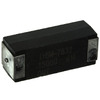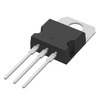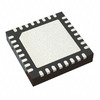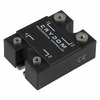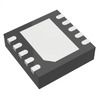A Complete Guide to SN74HC14N
When navigating the landscape of digital electronics, the SN74HC14N IC is a versatile tool that offers reliable hex inverter functionality with Schmitt-trigger inputs. Known for its adeptness in noise reduction and signal conditioning, this component is basic to stabilizing fluctuating signals and enhancing clarity in noisy environments. With six independent inverters on a single chip, the SN74HC14N provides flexibility across a broad range of applications, from waveform shaping to level shifting. This article explores its features, pin configurations, and practical applications, highlighting why it’s favored in fields like automotive systems, industrial automation, and digital communication for maintaining signal integrity.Catalog

Overview of SN74HC14N
The SN74HC14N holds a revered place in digital electronics due to its adaptability in providing hex inverter capabilities coupled with Schmitt-trigger inputs. This integrated circuit houses six distinct inverters on a single chip, which facilitates a broad spectrum of applications across diverse technological arenas. The incorporation of Schmitt-trigger inputs significantly aids in ensuring consistent and dependable logic-level transitions. These inputs play the ultimate role in reducing noise and enhancing signal fidelity, making the SN74HC14N highly advantageous in environments prone to interference or fluctuations in input voltages.
The benefit of having inverters with Schmitt-trigger attributes is embodied in their precision during challenging conditions. For example, in situations where input signals wobble due to environmental influences, the hysteresis quality serves as a stabilizing buffer. This function is frequently employed in devices demanding persistent signal clarity, such as oscillators or debounce circuits. Furthermore, you can often depend on the durability of the SN74HC14N for tasks where other inverters might struggle. Actual experiences suggest that incorporating Schmitt triggers into design architectures significantly reduces the likelihood of signal misinterpretation, emphasizing its efficacy in intricate circuits.
The successful implementation of the SN74HC14N requires careful examination of its electrical parameters to realize its full capabilities. This is frequently accomplished by effectively utilizing its noise-diminishing strengths, a tactic commonly adopted. The hysteresis function is useful in smoothing transition processes, ensuring circuits operate without abrupt shifts caused by transient disturbances. You can often gravitate towards this feature to bolster the operational dependability of their systems.
Pin Configuration
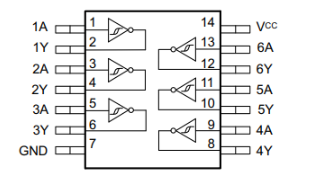
CAD Model
Symbol

Footprint
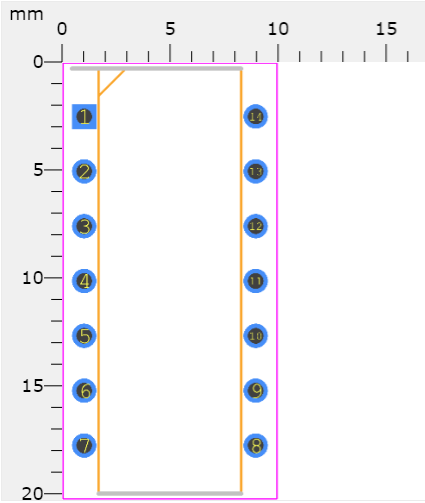
3D Model
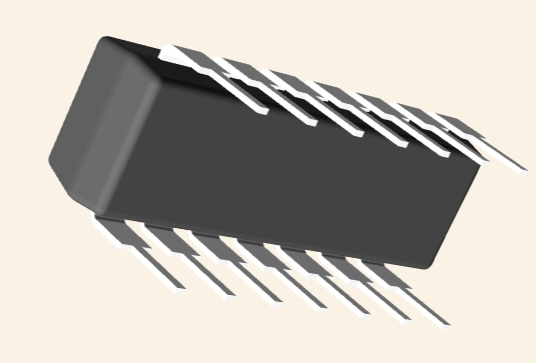
Features
|
Feature |
Description |
|
Flushed Inputs |
Ensures stable and reliable input transitions. |
|
Operating Voltage Range |
Broad range from 2V to 6V for versatile applications. |
|
Operating Temperature Range |
Supports operation in extreme conditions: -40°C to +85°C. |
|
Fanout Support |
Can drive up to 10 LSTTL loads. |
|
Power Savings |
Offers significant power savings compared to LSTTL logic
ICs. |
Technical Specifications
|
Type |
Parameter |
|
Lifecycle Status |
ACTIVE (Last Updated: 3 days ago) |
|
Factory Lead Time |
12 Weeks |
|
Contact Plating |
Gold |
|
Mount |
Through Hole |
|
Mounting Type |
Through Hole |
|
Package / Case |
14-DIP (0.300, 7.62mm) |
|
Number of Pins |
14 |
|
Weight |
927.99329mg |
|
Logic Level-High |
1.5V ~ 4.2V |
|
Logic Level-Low |
0.3V ~ 1.2V |
|
Operating Temperature |
-40°C ~ 85°C |
|
Packaging |
Tube |
|
Series |
74HC |
|
JESD-609 Code |
e3 |
|
Part Status |
Active |
|
Moisture Sensitivity Level (MSL) |
1 (Unlimited) |
|
Number of Terminations |
14 |
|
ECCN Code |
EAR99 |
|
Terminal Finish |
Matte Tin (Sn) |
|
HTS Code |
8542.39.00.01 |
|
Voltage - Supply |
2V ~ 6V |
|
Terminal Position |
DUAL |
|
Number of Functions |
6 |
|
Supply Voltage |
5V |
|
Terminal Pitch |
2.54mm |
|
Base Part Number |
74HC14 |
|
Pin Count |
14 |
|
Max Output Current |
5.2mA |
|
Operating Supply Voltage |
5V |
|
Supply Voltage-Max (Vsup) |
6V |
|
Number of Channels |
6 |
|
Load Capacitance |
50pF |
|
Output Current |
5.2mA |
|
Propagation Delay |
21 ns |
|
Quiescent Current |
2μA |
|
Turn On Delay Time |
155 ns |
|
Family |
HC/UH |
|
Logic Function |
Buffer, Inverter, Schmitt Trigger |
|
Logic Type |
Inverter |
|
Max I(ol) |
0.004 A |
|
Max Propagation Delay @ V, Max CL |
21ns @ 6V, 50pF |
|
Prop. Delay @ Nom-Sup |
31 ns |
|
Power Supply Current-Max (ICC) |
0.02mA |
|
Min Supply Voltage (DC) |
2V |
|
Schmitt Trigger Input |
Yes |
|
Features |
Schmitt Trigger |
|
Height |
5.08mm |
|
Length |
19.3mm |
|
Width |
6.35mm |
|
Thickness |
3.9mm |
|
REACH SVHC |
No SVHC |
|
Radiation Hardening |
No |
|
RoHS Status |
ROHS3 Compliant |
|
Lead Free |
Lead Free |
Components with Similar Specifications
|
Part Number |
Manufacturer |
Package / Case |
Number of Pins |
Logic Function |
Propagation Delay |
Min Supply Voltage |
Supply Voltage |
Quiescent Current |
Technology |
|
SN74HC14N |
Texas Instruments |
14-DIP (0.300, 7.62mm) |
14 |
Buffer, Inverter, Schmitt |
21 ns |
2 V |
5 V |
2 µA |
CMOS |
|
SN74HC04N |
Texas Instruments |
14-DIP (0.300, 7.62mm) |
14 |
- |
16 ns |
2 V |
5 V |
2 µA |
CMOS |
|
CD74HCU04E |
Texas Instruments |
14-DIP (0.300, 7.62mm) |
14 |
- |
12 ns |
- |
4.5 V |
2 µA |
CMOS |
|
SN74AHC04N |
Texas Instruments |
14-DIP (0.300, 7.62mm) |
14 |
- |
13 ns |
- |
3.3 V |
2 µA |
CMOS |
|
MC74HCU04ANG |
ON Semiconductor |
14-DIP (0.300, 7.62mm) |
14 |
- |
12 ns |
- |
3 V |
1 µA |
CMOS |
Applications
Digital Systems
In the world of digital systems, the SN74HC14N serves as a cornerstone for achieving precise clock input management, which enhances performance in microcontrollers and computing systems by stabilizing timing. It expertly synchronizes digital circuits, which helps to prevent timing discrepancies, minimizing the risk of data errors.
Switch Control
When it comes to switching control, the SN74HC14N shines with its swift response times and ability to mitigate signal bounce, a notorious issue with mechanical switches. Implementing this IC in consumer electronic circuits leads to interfaces that are more dependable, ensuring efficient input recognition that resonates with your expectations.
Digital Signal Inversion
This IC is celebrated for its digital signal inversion abilities, offering versatility in complex circuits by inverting undesirable logic states, a technique prevalent in communication systems to align signal needs. For example, in networking hardware, successful signal inversion enhances compatibility across different components, thus simplifying integration and fostering unity within diverse setups.
Signal Conditioning and Noise Filtering
Exhibiting proficiency in signal conditioning, the SN74HC14N ensures the integrity of electronic communications by refining input signals to reduce jitter and prevent surges that could otherwise unravel data transmissions. Its prowess in noise filtering proves advantageous in environments plagued by electromagnetic interference, mostly in industrial automation, where maintaining reliability is a deeply held commitment.
Level Shifting and Interfacing
In digital logic frameworks, the SN74HC14N facilitates level shifting, addressing voltage disparities between components, which is active in mixed-voltage systems to ensure smooth interoperability. Such level shifting is instrumental in robotics, where it upholds seamless communication between sensors and processing units, paving the way for efficient data processing and actionable insights.
Package

Datasheet PDF
SN74HC14N Datasheets:
SN74HC04N Datasheets:
CD74HCU04E Datasheets:
About us
ALLELCO LIMITED
Read more
Quick inquiry
Please send an inquiry, we will respond immediately.
Frequently Asked Questions [FAQ]
1. What are the voltage and current specifications of SN74HC14N?
The SN74HC14N runs smoothly within a power supply voltage span of 2 to 6 volts. It supports an output current of up to 6 mA for each pin while reaching a combined package cap of 50 mA. This broad voltage range caters to numerous digital systems, allowing for extensive adaptability. Considering the current limits is active in circuit assembly to avoid performance issues or hardware damage, mostly in situations demanding multiple high-level signal outputs.
2. What are the typical applications of SN74HC14N?
The SN74HC14N finds its place in digital settings for signal conditioning, noise reduction, waveform manipulation, and level transitioning tasks. This integrated circuit also plays a role in microcontrollers, digital communication setups, and robotics, as well as other general digital logic components. You can often harness its Schmitt-trigger inputs to counteract signal instability in noise-heavy environments. Its contribution to maintaining signal reliability is remarkable in automated solutions. Drawing from personal insights in digital engineering, understanding how IC specifications align with project needs fuels the creation of adept electronic systems.

ESP-01 Wi-Fi Module Guide: Pinout, Features, and Comparison with ESP8266
on November 16th

DHT11 Sensor Guide
on November 15th
Popular Posts
-

What is GND in the circuit?
on January 1th 3291
-

RJ-45 Connector Guide: RJ-45 Connector Color Codes, Wiring Schemes, R-J45 Applications, RJ-45 Datasheets
on January 1th 2824
-

Understanding Power Supply Voltages in Electronics VCC, VDD, VEE, VSS, and GND
on November 20th 2680
-

Fiber Connector Types: SC Vs LC And LC Vs MTP
on January 1th 2271
-

Comparison Between DB9 and RS232
on January 1th 1891
-

What Is An LR44 Battery?
Electricity, that ubiquitous force, quietly permeates every aspect of our daily lives, from trivial gadgets to life-threatening medical equipment, it plays a silent role. However, truly grasping this energy, especially how to store and efficiently output it, is no easy task. It is against this background that this article will focus on a type of coin cell battery that may seem insignificant on the...on January 1th 1849
-

Understanding the Fundamentals:Inductance Resistance, andCapacitance
In the intricate dance of electrical engineering, a trio of fundamental elements takes center stage: inductance, resistance, and capacitance. Each bears unique traits that dictate the dynamic rhythms of electronic circuits. Here, we embark on a journey to decipher the complexities of these components, to uncover their distinct roles and practical uses within the vast electrical orchestra. Inductan...on January 1th 1817
-

What Is RF and Why Do We Use It?
Radio Frequency (RF) technology is a key part of modern wireless communication, enabling data transmission over long distances without physical connections. This article delves into the basics of RF, explaining how electromagnetic radiation (EMR) makes RF communication possible. We will explore the principles of EMR, the creation and control of RF signals, and their wide-ranging uses. The article ...on January 1th 1816
-

CR2430 Battery Comprehensive Guide: Specifications, Applications and Comparison to CR2032 Batteries
What is CR2430 battery ?Benefits of CR2430 BatteriesNormCR2430 Battery ApplicationsCR2430 EquivalentCR2430 VS CR2032Battery CR2430 SizeWhat to look for when buying the CR2430 and equivalentsData Sheet PDFFrequently Asked Questions Batteries are the heart of small electronic devices. Among the many types available, coin cells play a crucial role, commonly found in calculators, remote controls, and ...on January 1th 1806
-

Comprehensive guide to hFE in transistors
Transistors are crucial components in modern electronic devices, enabling signal amplification and control. This article delves into the knowledge surrounding hFE, including how to select a transistor's hFE value, how to find hFE, and the gain of different types of transistors. Through our exploration of hFE, we gain a deeper understanding of how transistors work and their role in electronic circu...on November 20th 1795















